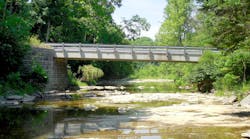County designs SRW abutments to replace failing bridge
This Ohio bridge was replaced in 2005 with the help of abutments made of Redi-Rock segmental retaining wall blocks.
"I came up with the design using Redi-Rock because it was a winter project and we didn't want to pour monstrous abutments," the county engineer said. How does the bridge look now, 10 years later? You might be surprised.
The Challenge: Deteriorating Bridge Abutments
In the world of retaining walls, engineers are often faced with two choices: (1) specifying a structural yet unattractive wall, or (2) specifying an attractive wall that isn't structural.
When Clermont County engineers discovered that the bridge abutments supporting the Gaynor Road Bridge were deteriorating, they were forced to close the bridge. For a year and a half, the county debated solutions for reconstructing the bridge. The county needed a structural retaining wall to act as a bridge abutment, but they also wanted the solution to be attractive.
Several factors influenced the decision the county eventually came to:
- Aesthetics: the new bridge abutments needed to look good, because an educational nature preserve was directly adjacent to the bridge.
- Cost: The county was looking for a cost-effective, structural solution that would allow them to utilize their own equipment and crews to install.
- The ability to install in harsh weather: Originally, the county considered using cast-in-place abutments, vertical piers, or reinforced concrete grade beams. But since construction needed to take place in the dead of winter, the county needed a solution that wouldn’t require provisions for heating and curing.
The Solution: New Bridge Abutments Using Redi-Rock Retaining Walls
Based on these needs, Clermont County's Bridge Engineer Todd Gadbury, P.E., chose to design the new bridge abutments using Redi-Rock retaining walls.
"I came up with the design using Redi-Rock because it was a winter project and we didn't want to pour monstrous abutments," Gadbury said. "Using Redi-Rock worked well in this application."
By using Redi-Rock's massive 1-ton retaining wall blocks, the county was able to construct structural walls that could act as abutments more cost effectively than cast-in-place.
Redi-Rock's Cobblestone texture blocks are cast in molds taken from natural quarried stone. Even though each block has nearly 6 sq ft of face, the Cobblestone texture has the appearance of six smaller blocks, giving finished walls a more natural look.
Redi-Rock's unique interlocking system installs simply, using a small crew and a piece of heavy machinery such as a backhoe. Installing the walls has a fast learning curve, which proved beneficial for the county's crew.
As construction began, the bridge deck was lifted off the existing abutments. Since the bridge deck was still in good condition, it was set aside to be reused. The crew removed the existing abutments, exposing a heavily eroded bank.
The county's crew excavated a 5 ft (1.5 meter) deep by 5 ft (1.5 meter) wide trench, reaching gray shale and thinly bedded limestone bedrock. The crew then poured concrete into the trench to create a concrete leveling pad for the abutments. Gadbury had specified a concrete curb at the front of the concrete leveling pad.
Like a giant Lego block, each Redi-Rock block interlocks with the one above and below it, creating a structural wall. Because the blocks were manufactured off-site by local Redi-Rock manufacturer, Redi-Rock Structures of OKI, the walls did not require provisions for heating and curing, even though they were installed in cold weather.
Once the walls reached the proper height, the crew constructed a reinforced concrete grade beam that bears directly on the Redi-Rock blocks. On top of the grade beam, the county used two cranes to set the reinforced concrete bridge box beams directly on the concrete grade beam. There are no piers or piles or deep foundations to hold the bridge deck up; the load of the bridge rests directly on the abutments.
The Outcome:
Ten years later, the photos show that the Gaynor Road Bridge looks exactly the same as it did when it was completed in 2005, despite multiple freeze thaw cycles and storm events.
Download a copy of the Redi-Rock Design Resource Manual at redi-rock.com/drm.
